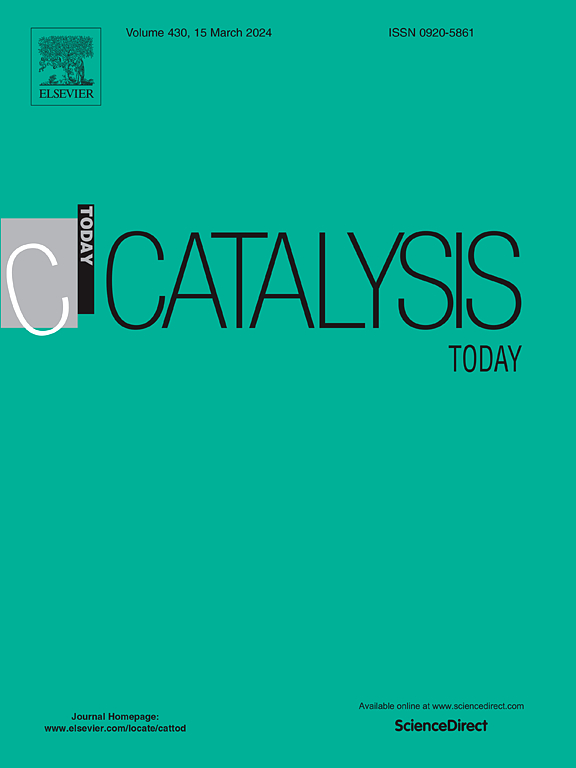An investigation of the impact of niobia loading on platinum catalysts for sour medium-temperature shift reaction
IF 5.2
2区 化学
Q1 CHEMISTRY, APPLIED
引用次数: 0
Abstract
The increasing demand to reduce pollutant emissions, coupled with the declining availability of mineral resources, has heightened the need for technologies that maximize the use of existing resources. Waste gasification is an interesting way to meet this demand, as it enables the production of hydrogen. However, in this gasification process, in addition to hydrogen, carbon monoxide is generated in considerable concentrations, making it necessary to adjust the CO/H2 ratio through the water-gas shift reaction. In addition the gasification of industrial and urban waste can contain significant concentrations of sulfur that act as a poison for traditional catalysts. As a result, there is an ongoing search for sulfur-tolerant catalysts that can prevent deactivation and eliminate the need for a desulfurization step. Building on the promising results of the Pt/Nb2O5 catalyst, new catalysts containing niobia were investigated to assess the impact of niobia loading in the support. In this series of catalysts, increasing the niobium content only leads to higher activity if it does not reduce the niobium surface coverage. Additionally, smaller platinum particle sizes are found to be more favorable for better performance in the water-gas shift reaction. However, the use of Al2O3-Nb2O5 supports did not impart properties to the platinum catalysts comparable to those of the Pt/Nb2O5 catalyst. These catalysts exhibited lower catalytic activity and did not provide sulfur tolerance, regardless of the niobium content. The interaction between platinum and niobia may not have been strong enough to produce the same synergy observed in the Pt/Nb2O5 system.
铌负载对酸性中温变换反应铂催化剂性能影响的研究
减少污染物排放的要求日益增加,再加上矿物资源的可得性不断下降,因此更需要能够最大限度地利用现有资源的技术。废物气化是满足这一需求的一种有趣的方式,因为它使氢气的生产成为可能。然而,在这种气化过程中,除了氢气外,还会产生相当浓度的一氧化碳,因此需要通过水气移位反应来调节CO/H2比。此外,工业和城市废物的气化可能含有高浓度的硫,这对传统的催化剂来说是一种毒药。因此,人们一直在寻找耐硫催化剂,以防止失活并消除脱硫步骤的需要。在Pt/Nb2O5催化剂取得良好效果的基础上,研究了含铌的新型催化剂,以评估铌在载体中负载的影响。在该系列催化剂中,只有在不降低铌表面覆盖率的情况下,增加铌含量才能获得更高的活性。此外,更小的铂颗粒尺寸更有利于在水气转换反应中获得更好的性能。然而,使用Al2O3-Nb2O5载体并没有赋予铂催化剂与Pt/Nb2O5催化剂相媲美的性能。这些催化剂表现出较低的催化活性,并且不具有耐硫性,无论铌含量如何。铂和铌之间的相互作用可能不足以产生在Pt/Nb2O5体系中观察到的相同协同作用。
本文章由计算机程序翻译,如有差异,请以英文原文为准。
求助全文
约1分钟内获得全文
求助全文
来源期刊

Catalysis Today
化学-工程:化工
CiteScore
11.50
自引率
3.80%
发文量
573
审稿时长
2.9 months
期刊介绍:
Catalysis Today focuses on the rapid publication of original invited papers devoted to currently important topics in catalysis and related subjects. The journal only publishes special issues (Proposing a Catalysis Today Special Issue), each of which is supervised by Guest Editors who recruit individual papers and oversee the peer review process. Catalysis Today offers researchers in the field of catalysis in-depth overviews of topical issues.
Both fundamental and applied aspects of catalysis are covered. Subjects such as catalysis of immobilized organometallic and biocatalytic systems are welcome. Subjects related to catalysis such as experimental techniques, adsorption, process technology, synthesis, in situ characterization, computational, theoretical modeling, imaging and others are included if there is a clear relationship to catalysis.
 求助内容:
求助内容: 应助结果提醒方式:
应助结果提醒方式:


